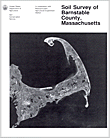The following is a map unit description from the "Soil Survey of Barnstable County, Massachusetts (Fletcher, 1993)"

NaB-Nantucket sandy loam, 3 to 8 percent slopes. This very deep, gently sloping, well drained soil is on the crests and sides of hills in areas of ground moraine and glacial lake deposits. It makes up about 0.3 percent (885 acres) of the survey area. It is mapped mainly in the Plymouth-Carver-Barnstable general soil map unit. Areas are irregular in shape and range from 2 to 50 acres in size.
Typically, the surface is covered with a 2-inch organic layer of loose, undecomposed leaves and twigs and partly decomposed and well decomposed organic material. The surface layer is sandy loam about 5 inches thick. The upper 1 inch is very dark grayish brown and very friable, and the lower 4 inches is dark yellowish brown and friable. The subsoil is friable sandy loam about 22 inches thick. The upper 12 inches is yellowish brown, and the lower 10 inches is light olive brown. The substratum to a depth of 65 inches or more is light olive brown, firm loam. Below a depth of 65 inches, it may have layers of loose sand and gravel.
Included with this soil in mapping are small areas of Barnstable, Boxford, and Plymouth soils. Also included are areas where slopes are less than 3 percent or more than 8 percent and a few areas where stones are on the surface. Included soils make up about 30 percent of this unit.
Permeability is moderate or moderately rapid in the subsoil of the Nantucket soil and moderately slow or slow in the substratum. Available water capacity is moderate. Depth to the seasonal high water table is generally more than 6 feet. In some areas, however, the soil has a perched water table at a depth of 2.0 to 2.5 feet in early spring.
Most areas are used as woodland. Many areas have been developed for homesites, and a few areas are farmed.
This soil is well suited to cultivated crops. Good tilth can be easily maintained. Erosion is a management concern. Farming on the contour or across the slope, terracing, stripcropping, including grasses and legumes in the crop rotation, growing cover crops, and applying a system of conservation tillage help to control runoff and erosion. Mixing crop residue and manure into the surface layer helps to maintain good tilth and increases the organic matter content.
This soil is well suited to hay and pasture. Proper stocking rates, deferred grazing, and rotation grazing help to maintain desirable pasture species.
This soil is fairly well suited to woodland. No major hazards or limitations restrict woodland management. Thinning dense stands to standard stocking levels results in more vigorous tree growth. Removal or control of competing vegetation may be necessary for the best growth of newly established seedlings. The most common trees are pitch pine, eastern white pine, black oak, scarlet oak, and white oak.
This soil is suitable as a site for buildings with or without basements. In areas where the soil has a perched water table, wetness is a limitation on sites for dwellings with basements and for septic tank absorption fields. The moderately slow or slow permeability in the substratum also is a limitation on sites for septic tank absorption fields. Additions of fill or a regional drainage system helps to overcome the wetness. Enlarging the absorption field helps to overcome the restricted permeability. In areas where the soil is underlain by sandy and gravelly material below a depth of 65 inches, excavations that extend to this material generally can overcome the wetness and the restricted permeability.